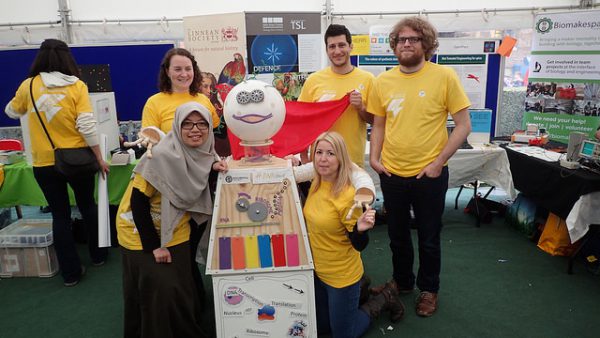This post comes to you from our friends at Biomakespace! They are biohackers and electrophysiology enthusiasts who work and hack with our kits along with inventions of their own! They recently presented and demoed their cool tech at the annual Cambridge Science Festival in Massachusetts. We asked them a couple questions about the event and their experience using and demoing the Backyard Brains SpikerShield, and they were kind enough to prepare this debrief for us which we’re sharing with you today!
…
The annual Cambridge Science Festival welcomes over 40,000 visitors of all ages to hundreds of events developed and run by staff and students from departments and organizations across the University and research institutions, charities and industry around Cambridge. Events include talks, interactive demonstrations, hands-on activities, film showings, and debates.
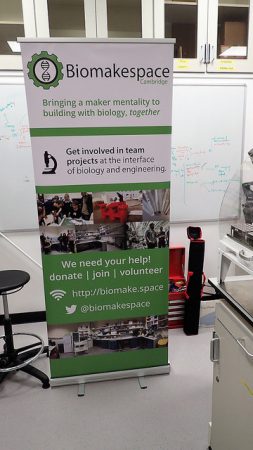 Over 1200 visitors streamed through the Plant and Life Sciences Marquee where Biomakespace had an activity table, with many stopping to find out about Biomakespace and the types of equipment/activities we had on display and where people could participate. There were a lot of families with young children, but also groups of students and adults.
Over 1200 visitors streamed through the Plant and Life Sciences Marquee where Biomakespace had an activity table, with many stopping to find out about Biomakespace and the types of equipment/activities we had on display and where people could participate. There were a lot of families with young children, but also groups of students and adults.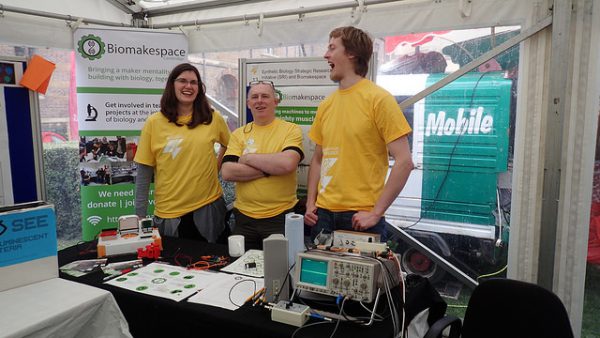
Roger, our resident electrophysiology expert was reading electrical signals from the gastrocnemius muscle in the lower leg and the brachioradialis muscle in the forearm using a battery powered bioamplifier and viewing them on an oscilloscope as well as creating noise from a speaker. Visitors were really interested to see how their signals varied in ‘intensity’, both amplitude and frequency, depending on the degree of effort involved in muscle contraction and also how easy it is to observe the firing of individual ‘motor units’.
Roger also demonstrated ‘reflex arcs’ by tapping the Achilles tendon in the lower leg or the distal brachioradialis tendon in the forearm. This usually requires a ‘reflex hammer’ containing an accelerometer, but he rigged up a normal hammer with a rubber-cushioned micro switch and a 9V battery attached with heat shrink to record the timing and intensity of the strike and observe the response. Reflex arcs can be unconsciously enhanced by clenching your teeth and interlocking fingers (the classic Jendrassik Maneuver) and also by imagining something that makes you really angry (mental-imagery interference), so we tried that out as well with some great results.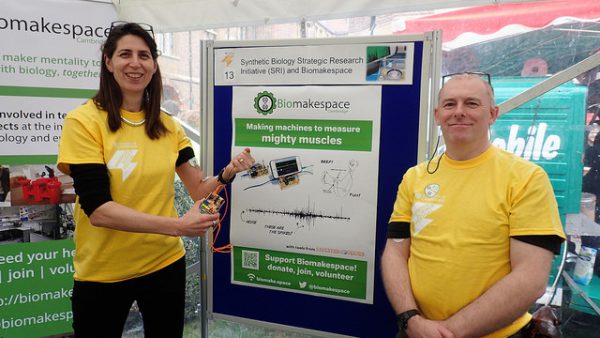
We had a demo with the Backyard Brains SpikerShield on an Arduino Uno. This has a series of green, yellow and red LEDs indicating the response amplitude. A long line of children excitedly tried to flex their arms to get the red LEDs to light up (which wasn’t too difficult with where we’d set the thresholds!) – we explained that although Roger’s full setup is large and can be expensive, it’s now possible to do some great experiments with low-cost hardware and a mobile phone – which is the message and ethos that Biomakespace and Backyard Brains value above all else.
Technical details:
We performed EMG recordings from the gastrocnemius muscle in the lower leg and the brachioradialis muscle in the forearm using Gold ECG Electrodes (Ag/AgCl/solid adhesive; pre-gelled: TIGA-MED, Deutschland GmbH). Differential signals were amplified 1000X or 5000X, and filtered (low pass: 30 Hz – 300 Hz, high-pass: 800 Hz – 15 kHz, depending on the experiment) using a battery powered bioamplifier and viewed on a Hameg HM407-2 Analog/Digital Oscilloscope and monitored by a conventional PC audio amplifier.
Volunteers were shown how these signals varied in ‘intensity’, both amplitude and frequency, depending on the degree of effort involved in muscle contraction and also how easy it is to observe the firing of individual ‘motor units’.
Practical demonstrations of ‘reflex arcs’ were made by localized tapping of: (i) the Achilles tendon in the lower leg, and (ii) the distal brachioradialis tendon in the forearm. In the absence of a ‘reflex hammer’ containing an accelerometer, an effective alternative was achieved with a rubber-cushioned micro push-switch (RS Components 336-74) and a 9V PP3 battery attached to a light (4 Oz/114 g) hammer using heat shrink. Activation of the switch upon tapping the tendons produced a signal that was made compatible with the ‘trigger input’ of the oscilloscope by a Grass Model SIU5B Stimulus Isolator Unit.
The principle of unconscious modulatory control of such reflex arcs was shown utilizing the classic Jendrassik Maneuver and also by mental imagery interference, both having the effect of markedly enhancing the reflex-based EMG activity.
The Muscle Spikershield is a great way to get people experimenting with neurobiology in an easy to understand way and the kit gives so many opportunities for other learning as well: basic electronics, soldering skills, how an amplifier works and coding with Arduino. The Science Makers monthly meetup at Cambridge Makespace, which was instrumental in getting the Biomakespace group together, has used the Muscle SpikerShield and other Backyard Brains boards at several meetups, from constructing the kits to experimenting with muscles, worms, plants and trying to control objects. Everyone has loved it and it’s fantastic for demos – we’ve also had several people asking where they can get one of their own.
Children were really attracted to the Muscle SpikerShield activity as it allowed them to learn something about themselves through the link between the number of lights lighting up and muscle activity, which isn’t something many had experienced before. Adults were interested to see how devices like the Muscle Spikershield can show similar scientific concepts to the more expensive lab equipment and also saw the value as a teaching resource. And it is a lot of fun too! Boys were very keen to show their strength and tried to light up all the lights on the SpikerShield as well as try and make the most noise when their muscles were hooked up to the Analog/Digital Oscilloscope and amplifier – especially when they competed with their dads!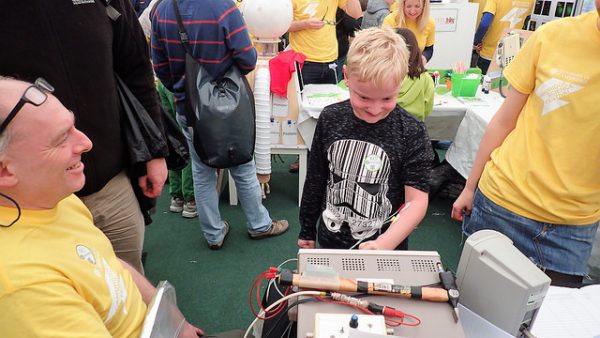
Teaching Electrophysiology is important because it helps people understand how the brain and the nervous system work, which is fundamental to understanding who we are as human beings. The great thing in terms of experimenting with electrophysiology is that even at a simple level, people can find out things new things for themselves and there are so many tricks that illuminate how our brains and bodies work on a subconscious level, like the reflex arc experiments Roger was carrying out in his demo. Although electrophysiology is not a new field of science, combined with new technologies, such as advanced genetic and optical techniques, it allows to gain understanding on a wide variety of scales- from single ion channel proteins to whole organs systems and whole organisms and that keeps it really exciting.
Electrophysiology is going to play a big role in our future. First off we’ll be building and collecting devices to set up the ‘electrophysiology corner’ in the workshop and after that, the projects will be community-led. Some ideas that have already been bounced around include recording spontaneous activity in invertebrates, investigating neuroplasticity in snails and record currents associated with growth or movement in plants and slime molds. Some people are very interested in combining 3D-printing with electrophysiology kit to look at customized fitting and modified control mechanisms. One group who are associated with the space and the Science Makers group have been working for over a year on a fork of the Backyard Brains plant electrophysiology board and have re recently rigged up custom controllers for electrode micromanipulators with Playstation 2 controllers – we’d love to see more of that!
Biomakespace is a non-profit organization creating a community laboratory on the Cambridge Biomedical Campus in Cambridge, UK. We aim to build a community of scientists, engineers, technologists, entrepreneurs, teachers, artists and members of the public interested in engineering with biology. Biomakespace provides members with affordable access to a well-equipped lab and prototyping space as well as to training and social events. By encouraging and supporting project-based interdisciplinary collaborations, Biomakespace aims to contribute to awareness, knowledge and innovation in engineering with biology. As the community grows, we aim to open the space to the public for events.
Visit our website (http://biomake.space) to find out more. To become a member or support us, visit (https://biomake.space/support-us)
